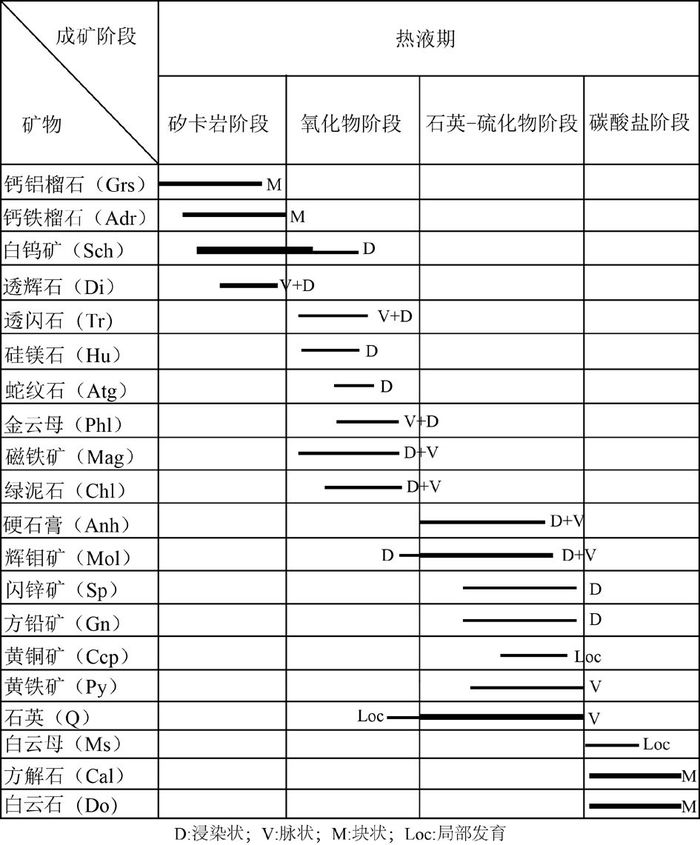2. 合肥工业大学矿床成因与勘查技术研究中心, 合肥 230009;
3. 安徽省地质矿产勘查局327地质队, 合肥 230011
2. Ore Deposit and Exploration Centre, Hefei University of Technology, Hefei 230009, China;
3. No. 327 Geological Party, Anhui Bureau of Geology and Mineral Exploration, Hefei 230011, China
白钨矿(CaWO4)在矽卡岩型、斑岩型和石英脉型矿床中广泛发育(Allen and Folinsbee, 1944; 徐克勤, 1957; Noble et al., 1984; 刘英俊和马东升, 1987; 张学玉等, 1990; Uspensky et al., 1998; Peng et al., 2003; Wang et al., 2008)。由于白钨矿在空间和时间上常与自然金、黄铜矿和辉钼矿等矿石矿物关系密切,且常富含稀土元素、Sr、Y和Pb等微量元素(Cottrant, 1981; Raimbault et al., 1993),可提供成矿流体氧逸度信息(Sun et al., 2017)。白钨矿中的Sm-Nd体系中相对稳定(Migdisov et al., 2009),白钨矿Sm-Nd同位素常用于确定成矿作用时间和成矿物质来源(Bell et al., 1989; Anglin et al., 1996; Zhao and Jiang, 2004; Robert et al., 2006; 刘琰等, 2007; Peng et al., 2006)。
长江中下游成矿带作为中国重要的铜铁金多金属成矿带(常印佛等, 1991; 唐永成等, 1998; 华仁民和毛景文, 1999; 毛景文等, 2004; 周涛发等, 2008, 2016, 2017; Pirajno and Zhou, 2015),近年在成矿带北亚带发现了东顾山钨矿床,其成矿作用明显不同于该成矿带内已知的斑岩型铜金矿床和玢岩型铁矿床,年代学研究表明,东顾山钨矿床是长江中下游成矿带新的一期成矿作用产物,已有学者对该地区的成岩成矿年代、岩体源区等方面做了相关的研究(聂利青等, 2016),但矿床成矿流体的演化和成矿物质来源等方面研究尚未开展。本文在对矿床中白钨矿进行详细的岩相学观察的基础上,通过电子探针和激光剥蚀电感耦合等离子质谱(LA-ICP MS)开展原位高精度的主、微量元素的分析和白钨矿的Sr-Nd同位素测试,揭示矿床中不同类型白钨矿的主微量元素成分特征,探讨白钨矿中REE加入晶格的机制和白钨矿的成矿热液来源和演化,阐明东顾山矿床成矿作用过程和成矿物质来源。通过与对比邻区其他钨矿床的白钨矿地球化学特征对比,分析讨论了基底对成矿作用的贡献。
2 矿床地质特征长江中下游成矿带受南北边界断裂及“中轴线”的主干断裂所控制,可分为大体上平行延伸的中亚带、南亚带和北亚带。中亚带为长江中下游成矿带的主体,集中了区内主要的铜、铁、硫铁矿、金、银、铅锌等矿床,分为鄂东南、九瑞、安庆-贵池、铜陵、庐枞、宁芜和宁镇7个矿集区。南亚带分布在常州-阳新断裂带的东段,成矿元素组合以钨、钼、铜为主,兼有金、锑、铅锌矿化,很明显地具有与江南隆起区过渡的成矿特色。北亚带位于中亚带庐枞矿集区和宁芜矿集区以北,位于成矿带北界黄栗树-破凉亭断裂之间。北亚带内已发现了滁州-马厂-沙溪等矿床集中分布区,都分布在北东向宿松-响水断裂与其它方向的断裂交汇处,以钨铜金组合为主(图 1)。
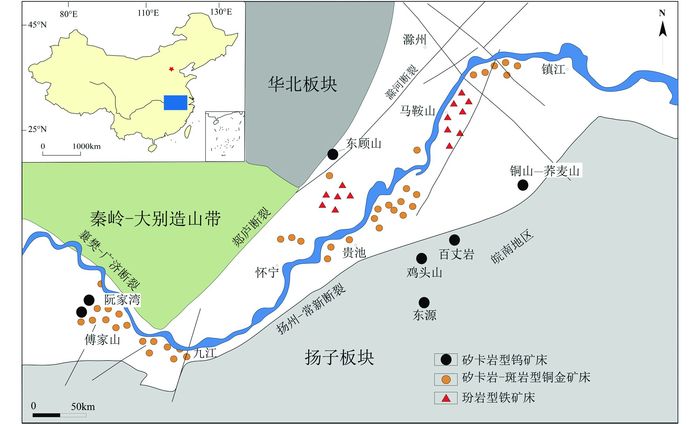
|
图 1 长江中下游成矿带地质略图及钨矿床分布图(底图据周涛发等, 2017修改) Fig. 1 Simplified geological map of Middle Lower Yangtze Metallogenic Belt (MLYB) and the distribution of tungsten deposits (after Zhou et al., 2017) |
本次工作研究的东顾山矿床位于长江中下游成矿带北亚带(图 1)。该矿床类型为矽卡岩型钨矿床,赋矿地层为奥陶系红花园组白云岩,区内发育多条小型导矿断裂构造(图 2),成矿岩体为东顾山黑云母花岗岩,钨矿体产在酸性岩体与地层的接触带中。矿体形态主要呈平缓透镜状、囊状和不规则状。初步圈定了钨矿体视厚度32.61m,含WO3平均品位0.19%,预计资源量可达大型规模(安徽省地质矿产勘查局327队,2016)。东顾山钨矿床中钨矿石主要金属矿物为白钨矿、辉钼矿、方铅矿和闪锌矿,还有少量磁铁矿、黄铁矿和黄铜矿。东顾山钨矿床的热液期分为四个阶段,分别为矽卡岩阶段、氧化物阶段、石英硫化物阶段和碳酸盐阶段(表 1)。其中矽卡岩阶段是钨矿的主成矿阶段,氧化物阶段是钨矿的次要成矿阶段。
|
|
表 1 东顾山矿床蚀变及矿化期次 Table 1 Mineralization and alteration stages and minerals of the Donggushan deposit |
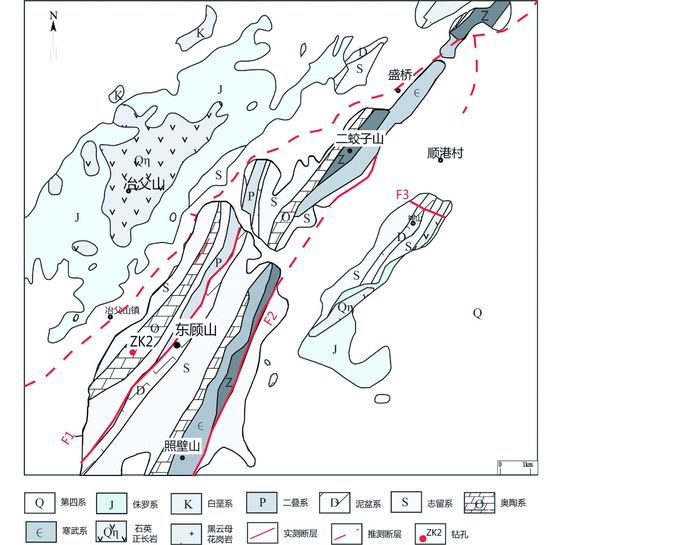
|
图 2 东顾山钨矿床地质图(据安徽省地质矿产勘查局327队,2016①修改) Fig. 2 Simplified geological map for the Donggushan tungsten polymetallic deposit |
① 安徽省地质矿产勘查局327队.2016.安徽庐江沙溪地区矿产地质调查报告(内部资料)
3 样品描述及分析方法本文采集了东顾山矿床中矽卡岩阶段(样品号ZK2-494、ZK2-781、ZK2-824)和氧化物阶段(样品号ZK2-328、ZK2-506、ZK2-990)的白钨矿样品,样品号的后三位数字为采样深度。矽卡岩阶段白钨矿为细粒他形结构(图 3a),粒径约0.5mm,与钙铝榴石和钙铁榴石共生(图 3c)。氧化物阶段白钨矿为细粒半自形-他形结构(图 3b),粒径约0.3~0.6mm,与磁铁矿、绿泥石、金云母、透辉石、透闪石、蛇纹石、硅镁石等矿物共生(图 3d)。
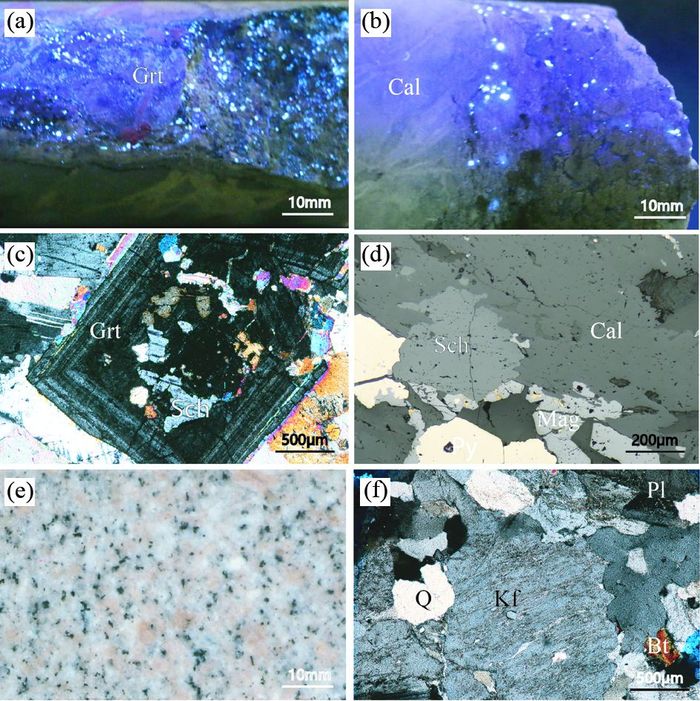
|
图 3 东顾山矿床的白钨矿和东顾山岩体黑云母花岗岩 (a、c)矽卡岩阶段的白钨矿;(b、d)氧化物阶段的白钨矿;(e、f)黑云母花岗岩. Sch-白钨矿;Di-透辉石;Grt-石榴子石;Cal-方解石;Mag-磁铁矿;Py-黄铁矿;Kf-钾长石;Q-石英;Pl-斜长石;Bt-黑云母 Fig. 3 Scheelites from different stage from Donggushan deposit and biotite granite of Donggushan intrusion (a, c) scheelite in skarn stage; (b, d) scheelite in quartz-sulfide stage; (e, f) biotite granite. Sch-scheelite; Di-diopside; Grt-garnet; Cal-calcite; Mag-magnetite; Py-pyrite; Kf-K-feldspar; Q-quartz; Pl-plagioclase; Bt-biotite |
本文采集了东顾山矿床中钻孔深部新鲜的黑云母花岗岩(ZK2)(图 3e),浅肉红色,半自形粒状结构,块状构造,主要由钾长石(25%)、石英(30%)、斜长石(An=0~30)(35%)、黑云母(10%)和少量副矿物组成(图 3f)。钾长石粒径0.3~0.6mm、无色、低负突起、解理不发育、斜消光、消光角较小、干涉色为Ⅰ级灰-灰白、双晶不发育、后期蚀变为钠长石化。斜长石(An=0~30)粒径约0.1~1mm,无色、低负突起、解理不发育、斜消光、消光角较小、干涉色为Ⅰ级灰-灰白、双晶纹细密、有些斜长石则不具双晶。黑云母粒径约100~500μm,单偏光褐黄色、多色性和吸收性极强、中正突起、一组极完全解理、干涉色鲜艳、平行消光、易受自身颜色影响。石英粒径约50~300μm,无色透明、低正突起、解理不发育、平行消光、干涉色为Ⅰ级灰-灰白、有时可达Ⅰ级黄白。
白钨矿主量元素的电子探针(EPMA)分析在合肥工业大学资源与环境工程学院电子探针室完成,仪器型号为JEOL JXA-8230。实验条件为:加速电压15kV,束斑尺寸3μm,探针电流20nA。所有元素的信号采集时间均为15s,背景时间均为5s,修正方法ZAF,检测限优于0.01%。
白钨矿原位微量元素含量分析在合肥工业大学资源与环境工程学院矿床成因与勘查技术研究中心(OEDC)矿物微区分析实验室利用LA-ICP-MS完成。激光剥蚀系统为CetacAnalyte HE,ICP-MS为Agilent 7900。激光剥蚀过程中采用氦气作载气、氩气为补偿气以调节灵敏度,二者在进入ICP之前通过一个T型接头混合。每个时间分辨分析数据包括40s的空白信号和40s的样品信号。对分析数据的离线处理(包括对样品和空白信号的选择、仪器ICPMS Data Cal使用说明灵敏度漂移校正和元素含量采用软件ICPMS DataCal(Liu et al., 2008)完成。详细的仪器操作条件和数据处理方法同宁思远等(2017)和汪方跃等(2017)。矿物微量元素含量利用多个参考玻璃(NIST610、NIST612、GSC-1G、GSD-1G和BCR-2G)作为多外标无内标的方法进行定量计算(Liu et al., 2008)。标准玻璃中元素含量的推荐值据GeoReM数据库(http://georem.mpch-mainz.gwdg.de/)。
白钨矿Sr-Nd同位素和黑云母花岗岩全岩Sr-Nd同位素化学前处理与质谱测定在南京聚谱检测科技有限公司完成。岩石粉末经高压密闭溶样弹消解后,先经过阳离子-锶特效联合树脂,分离出Sr、总稀土。总稀土组分再经过LN特效树脂,分离出Nd。Sr、Nd淋洗液被蒸干后,先用1.0mL 2%稀硝酸溶解,将其作为母液;取其中50mL,稀释成500mL,在Agilent 7700x四极杆型ICP MS上测定Sr、Nd准确含量。再用2%稀硝酸将Sr、Nd母液稀释成50×10-9 Sr、50×10-9 Nd。同位素溶液经Cetac Aridus Ⅱ膜去溶系统引入,在Nu Plasma Ⅱ MC-ICP MS上测定同位素比值。Sr同位素比值测定过程中,采用86Sr/88Sr=0.1194校正仪器质量分馏。Sr同位素国际标准物质NIST SRM 987作为外标,校正仪器漂移。Nd同位素比值测定过程中,采用146Nd/144Nd=0.7219校正仪器质量分馏。Nd同位素国际标准物质JNdi-1作为外标,校正仪器漂移。美国地质调查局USGS地球化学标准岩石粉末(玄武岩BCR-2、玄武岩BHVO-2、安山岩AGV-2、流纹岩RGM-2)作为质控盲样,经过以上化学前处理与质谱测定,白钨矿样品的Sr-Nd同位素比值实测值(143Nd/144Nd)(t)=0.511608~0.511684和黑云母花岗岩样品的Sr-Nd同位素比值实测值146Nd/144Nd=0.511718~0.511743在误差范围内与文献报道值一致(Weis et al., 2006)。
4 分析结果 4.1 白钨矿主量元素组成东顾山矿床矽卡岩阶段和氧化物阶段的白钨矿共6个样品18个探针点的主量元素结果见表 2。矽卡岩阶段白钨矿的CaO平均含量为20.19%,WO3平均含量为77.48%,MoO3平均含量为0.97%,PbO平均含量0.09%;氧化物阶段白钨矿的CaO平均含量为20.81%,WO3平均含量为78.79%,MoO3平均含量为0.26%,PbO平均含量位0.06%。以上两个阶段生成的白钨矿Cu、Fe含量低于或接近检测限,MoO3含量相对较高且同一样品中变化范围小。
|
|
表 2 东顾山矿床中白钨矿代表性样品的主量元素组成(wt%) Table 2 Representative major element compositions of scheelites from Donggushan ore deposit (wt%) |
6个白钨矿样品共有54个La微量元素分析点,结果见表 3。矽卡岩阶段白钨矿Mo平均含量约为6228×10-6;REE范围为98×10-6~555×10-6,平均含量约为325×10-6;HREE范围为13×10-6~77×10-6,平均含量约为43×10-6;LREE范围为79×10-6~552×10-6,平均含量约为282×10-6;LREE/HREE范围为3~10,平均约为7;δEu范围为0.13~0.78,平均值约为0.25。氧化物阶段白钨矿Mo平均含量约为1981×10-6;REE范围为77×10-6~153×10-6,平均含量约为118×10-6;HREE范围为4×10-6~22×10-6,平均含量约为11×10-6;LREE范围为71×10-6~139×10-6,平均含量约为107×10-6;LREE/HREE范围为5~30,平均约为13;δEu范围为0.30~0.68,平均值约为0.51。矽卡岩阶段和氧化物阶段两种白钨矿的稀土特征均为右倾型,即明显富集轻稀土亏损重稀土,从矽卡岩阶段到氧化物阶段白钨矿的稀土总量逐渐降低,负铕异常逐渐减弱(图 4)。
|
|
表 3 东顾山矿床中白钨矿样品稀土元素组成(×10-6) Table 3 Representative trace element compositions of scheelites from Donggushan deposit (×10-6) |
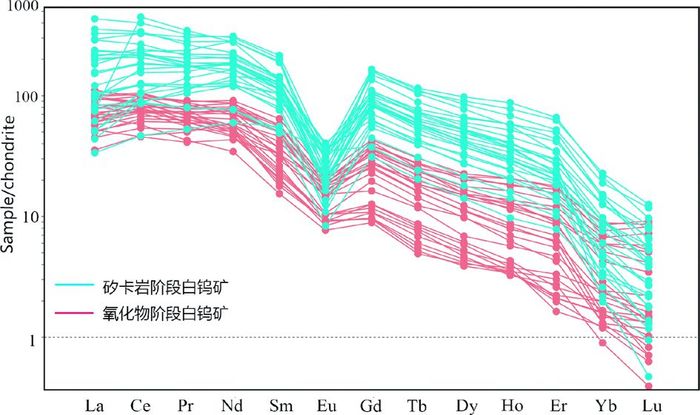
|
图 4 东顾山矿床白钨矿球粒陨石标准化稀土模式图(标准化值据Sun and McDonough, 1989) Fig. 4 Chondrite-normalized REE patterns of the Donggushan scheelite (normalization values after Sun and McDonough, 1989) |
白钨矿的Sr-Nd同位素特征见表 4。东顾山矿床中矽卡岩阶段和氧化物阶段两类白钨矿的87Sr/86Sr分别为0.70957~0.71002和0.70993~0.71126,143Nd/144Nd分别为0.51169~0.51176和0.51174~0.51177,东顾山矿床的成矿年龄为97.22Ma(聂利青等, 2016),计算得到的Sr-Nd同位素(143Nd/144Nd)(t)值分别为0.51160~0.51167和0.51165~0.51168,(87Sr/86Sr)(0)值分别为0.70956~0.71001和0.71125~0.71113,εNd(t)分别为-17.7~-16.4和-16.8~-16.2。东顾山矿床两类白钨矿的同位素组成基本相同。
|
|
表 4 东顾山钨矿床白钨矿Sr-Nd同位素分析结果 Table 4 Results of scheelite Sr-Nd isotopic analysis from the Donggushan W deposit |
东顾山岩体黑云母花岗岩全岩Sr-Nd同位素特征见表 5。实测的87Sr/86Sr为0.71052~0.71081,143Nd/144Nd为0.51171~0.51174,东顾山矿床的成岩年龄为99.7Ma(聂利青等, 2016),计算得到的Sr-Nd同位素(143Nd/144Nd)(t)值为0.51166~0.51169,(87Sr/86Sr)(0)值为0.70631~0.70666,εNd(t)为-16.5~-16.0。
|
|
表 5 东顾山岩体Sr-Nd同位素分析结果 Table 5 Sr-Nd isotopic results of the Donggushan intrusion |
白钨矿中铕离子的存在和价态受到温度、压力、氧逸度和成矿流体成分的控制(Ghaderi et al., 1999; 熊德信等, 2006; Brugger et al., 2008; 任云生等, 2010; Song et al., 2014)。稀土元素为三价,而铕元素可以在还原状态下为二价,因此铕异常可以用来指示成矿流体的氧化还原状态(Ghaderi et al., 1999; Brugger et al., 2000, 2002)。因此,在高氧逸度条件下Eu以三价替代白钨矿中的Ca2+,产生铕负异常。在低氧逸度条件下Eu以二价存在,比Sm和Gd更易进入白钨矿晶格中,产生铕正异常(Ghaderi et al., 1999; Brugger et al., 2000, 2002)。东顾山矿床的白钨矿的成矿热液由矽卡岩阶段到氧化物阶段铕负异常减弱(图 4),表明成矿流体氧逸度逐渐减弱。
白钨矿中除稀土元素可以表征氧化还原状态外,主微量元素也可以反应白钨矿形成时的氧逸度,氧化条件下,Mo以六价替换W6+,当氧逸度降低时,Mo6+则变为Mo4+并且沉淀为辉钼矿(MoS2)(Linnen and Williams-Jones, 1990; Rempel et al., 2009; Song et al., 2014)。东顾山矿床中矽卡岩阶段和氧化物阶段两类白钨矿中的Mo含量逐渐降低(图 5a),也反应了由矽卡岩阶段到氧化物阶段氧逸度降低。如前文所述,东顾山矿床中矽卡岩阶段和氧化物阶段白钨矿共生的最重要矿物分别为钙铁榴石和磁铁矿,钙铁榴石和磁铁矿均反映氧化环境,且钙铁榴石中铁为3+,磁铁矿中铁为3+和2+,这与白钨矿中铕负异常逐渐减弱的特征吻合;白钨矿主微量稀土元素和矿物共生组合均表明成矿流体氧逸度逐渐减弱。

|
图 5 东顾山矿床白钨矿中W与Mo关系图(a)及不同类型钨矿床中白钨矿稀土元素配分曲线模式图(b,标准化值据Sun and McDonough, 1989) 图中数据包括鸡头山钨钼矿床(Song et al., 2014)、百丈岩钨钼矿床(Song et al., 2014)、南秧田钨矿(曾志刚等, 1998)、雪宝顶钨锡铍矿床(刘琰, 2007) Fig. 5 Comparison of WO3 content (%) and MoO3 content (%) in scheelite from Donggushan deposit (a) and chondrite-normalized REE patterns of different type of tungsten deposits (b, normalization values after Sun and McDonough, 1989) Data sources: Jitoushan tungsten-molybdenum deposit (Song et al., 2014); Baizhangyan tungsten-molybdenum deposit (Song et al., 2014); Nanyangtian tungsten deposit (Zeng et al., 1998); Xuebaoding tungsten-tin-beryllium deposit (Liu et al., 2007) |
矽卡岩型矿床中的白钨矿稀土配分以右倾型(Skarn-1)为主,也可发育平坦型(Skarn-2),平坦型有显著的铕正异常且稀土总量范围比右倾型小;Skarn 1型根据铕异常特征可以分为Skarn-1a、Skarn-1b和Skarn-1c三类,(图 5b),分别表现出明显的负铕异常、微弱的或无铕异常和明显的正铕异常,分别代表了白钨矿形成环境为氧化、中性和还原,除此之外,三者均显示出轻稀土富集、重稀土亏损的右倾模式,表明富集中稀土元素的石榴子石、透辉石等矽卡岩矿物先于白钨矿沉淀,导致残余流体富集LREE、亏损HREE。本次工作中,东顾山矿床的白钨矿轻重稀土比值为3~30,平均值为11(表 3),表明东顾山矿床中白钨矿具有明显的右倾式稀土模型,富集轻稀土强烈亏损重稀土和负铕异常,符合矽卡岩矿床白钨矿稀土元素配分模式中的Skarn-1a类,即反映东顾山矿床中白钨矿形成于氧化环境且晚于石榴子石等富稀土矿物形成。
5.2 成矿岩浆岩成因在εNd(t)和(87Sr/86Sr)i相关图解(图 6)中,东顾山岩体样品集中分布于第四象限,位于扬子克拉通岩石圈地幔和扬子下地壳之间的演化线上,表明东顾山岩体的物质来源为壳幔混合,其中壳源比例占20%。
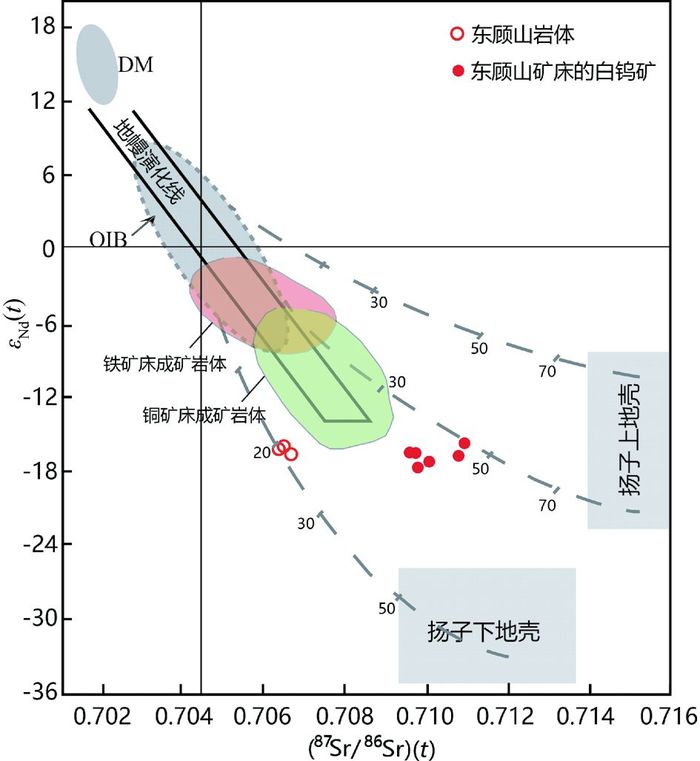
|
图 6 东顾山矿床白钨矿的Sr-Nd同位素协变图解 DM-亏损地幔;OIB-洋岛玄武岩; 图中带数字的虚线代表幔源物质与壳源物质之间的混合比例);长江中下游地区富集地幔端元的(87Sr/86Sr)i和εNd(t)分别为0.7059和-4.66(Wang et al., 2006),铜矿床成矿岩体和铁矿床成矿同位素数据王世伟(2015),张乐骏(2010)和宁芜研究项目编宁芜研究项目编写小组(1978) Fig. 6 Sr-Nd isotope diagram of Donggushan deposit DM-depleted mantle; OIB-Ocean Island basalts. The dotted line in the figure represents the mixing ratio between the mantle material and the crust material; (87Sr/86Sr)i and εNd(t) data of Enrichment mantle from MLYB are 0.7059 and -4.66, respectively (Wang et al., 2006), (87Sr/86Sr)i and εNd(t) data of ore-forming intrusions of copper and iron deposits are from Wang (2015), Zhang (2010) and Ningwu Project Group (1978) |
研究表明,长江中下游成矿带内形成铁矿床的岩浆岩落入地幔排列线与扬子上地壳的演化线上,指示岩浆源区为富集的交代地幔,交代地幔的形成与古板块的俯冲交代作用有关,在岩浆演化的过程中受到了一定的地壳物质的混染(唐永成等, 1998; 王元龙等, 2001; 袁峰等, 2008; 周涛发等, 2010)。长江中下游成矿带内形成铜矿床的岩浆岩为岩浆混合的结果(Wu et al., 2000; 吴才来等, 2003, 2008; Wang et al., 2015),一个端元来自富集地幔的基性岩浆,另一个端元来自加厚下地壳部分熔融的酸性岩浆。长江中下游成矿带鄂东矿集区的阮家湾大型矽卡岩型白钨矿矿床的成矿岩体全岩Sr-Nd同位素特征与成矿带形成铜矿床和形成铁矿床的岩体同位素特征相似(颜代蓉等, 2012),即起源于古老的富集地幔,并混染或混合了部分地壳物质。由上可知,不论是长江中下游成矿带内形成铁矿床的岩浆岩还是形成铜矿床的岩浆岩,再或者形成钨矿床的岩浆岩(例如东顾山矿床和阮家湾矿床)其源区均为壳幔混合,但混合程度不同。东顾山岩体全岩εNd(t)值更低说明东顾山岩体形成过程中有更多的地壳物质混入。综上,东顾山岩体岩浆源区为富集岩石圈地幔,并有约20%的扬子下地壳加入,即与长江中下游成矿带内形成铜矿和形成铁矿的岩体源区均为壳幔混合,而钨为壳源元素,说明东顾山岩体在上升过程同化混染了周围富集钨元素的地壳岩石,并最终形成钨矿床。
5.3 成矿物质来源有学者提出(任云生等, 2010),白钨矿中Rb/Sr、Nb/Ta和Zr/Hf可用来指示成矿物质来源。白钨矿中Rb/Sr、Nb/Ta和Zr/Hf元素比值范围和平均值落于地幔标准值之上,则成矿物质来源为幔源;若白钨矿中Rb/Sr、Nb/Ta和Zr/Hf元素比值范围和平均值落于地幔标准值之下,则成矿物质来源为壳源(Fu et al., 2017)。本文认为,通过白钨矿中Rb/Sr、Nb/Ta和Zr/Hf元素比值判断成矿物质来源可靠性低,因为白钨矿的晶格允许Sr进入而不允许Rb进入(Deer et al., 1996),使得测得的白钨矿中Rb含量极低(小于1×10-6),有些甚至低于检测限(0.01×10-6)而没有数值,这就导致Rb数值小且不准确,进而使得Rb/Sr比值不准确,不能真实反映成矿流体信息。
白钨矿中Nb/Ta和Zr/Hf比值高,含量远高于检测限,可以获得准确数值。通过收集前人资料(Sun and Chen, 2017),可知钦杭成矿带大湖塘矿床白钨矿的Zr/Hf比值数据范围将包括原始地幔Zr/Hf比值包括在内,这与前人所得结论大湖塘矿床白钨矿成矿物质来源为地壳不一致,这一反例说明白钨矿中Rb/Sr、Nb/Ta和Zr/Hf比值不能准确反映成矿物质来源,所以,本文采用白钨矿的Sr-Nd同位素特征说明成矿流体来源。
白钨矿中的同位素特征可以反应成矿流体和成矿作用的关系(Bell et al., 1989)。东顾山矿床中两类白钨矿的εNd(t)范围为-17.7~-16.2,87Sr/86Sr(0)值(0.70956~0.71113)明显大于成矿岩体黑云母花岗岩87Sr/86Sr(0)值(平均0.706455),表明钨等成矿元素应由岩浆源区和上地壳共同提供。由于长江中下游成矿带抬升较浅,仅零星地分布着代表上地壳的中浅变质岩系(董岭群、双桥山群等)分属北基底和南基底,东顾山地区上地壳物质为北基底董岭群(马振东和单光祥, 1997),综上,东顾山矿床成矿物质由董岭式基底和东顾山岩体提供。
前人研究表明基底的基性程度和含矿性对长江中下游成矿带形成的铜铁矿床有明显的控制作用(马振东和单光祥, 1997),W等亲氧元素在南北基底含量的差异显而易见的(平均值分别为0.736和3.399,马振东和单光祥, 1997),这种南基底(双桥山群等)富W等亲氧元素特征,明显地在江南中生代壳熔花岗岩的成岩、成矿作用中显露出来了(例如大湖塘钨矿床成矿物质来源于双桥山群(Sun and Chen, 2017)),这也是有学者认为“高钨”不过江的规律(中下扬子地区)的重要原因(马振东和单光祥, 1997)。而本文认为董岭式基底也可以为钨矿床提供成矿物质,这就解释了南钨北移的界限可以越过长江深断裂。
6 结论(1) 东顾山矿床中,由矽卡岩阶段过渡到氧化物阶段,白钨矿过的铕负异常减弱,同时Mo6+含量降低,指示成矿流体氧逸度逐渐减弱;
(2) 东顾山岩体全岩Sr-Nd同位素(87Sr/86Sr)(0)值为0.70631~0.70666,εNd(t)为-16.5~-16.0,东顾山岩体岩浆源区为富集岩石圈地幔,并有约20%的扬子下地壳加入;
(3) 东顾山钨矿床中两类白钨矿的εNd(t)范围为-17.7~-16.2,87Sr/86Sr(0)值为0.70956~0.71113,表明东顾山矿床中白钨矿的成矿物质由应由岩浆源区和上地壳共同提供;
(4) 董岭式基底可以为钨矿床提供成矿物质,因此南钨北移的界限可以越过长江深断裂。
Allen CC and Folinsbee RE. 1944. Scheelite veins related to porphyry intrusives, Hollinger Mine. Economic Geology, 39(5): 340-348. DOI:10.2113/gsecongeo.39.5.340 |
Anglin CD, Jonasson IR and Franklin JM. 1996. Sm-Nd dating of scheelite and tourmaline:Implications for the genesis of Archean gold deposits, Val d'Or, Canada. Economic Geology, 91(8): 1372-1382. DOI:10.2113/gsecongeo.91.8.1372 |
Bell K, Anglin CD and Franklin JM. 1989. Sm-Nd and Rb-Sr isotope systematics of scheelites:Possible implications for the age and genesis of vein-hosted gold deposits. Geology, 17(6): 500-504. DOI:10.1130/0091-7613(1989)017<0500:SNARSI>2.3.CO;2 |
Brugger J, Bettiol AA, Costa S, Lahaye Y, Bateman R, Lambert DD and Jamieson DN. 2000. Mapping REE distribution in scheelite using luminescence. Mineralogical Magazine, 64(5): 891-903. DOI:10.1180/002646100549724 |
Brugger J, Mass R, Lahaye Y, McRae C, Ghaderi M, Costa S, Lambert D, Bateman R and Prince K. 2002. Origins of Nd-Sr-Pb isotopic variations in single scheelite grains from Archaean gold deposits, Western Australia. Chemical Geology, 182(2-4): 203-225. DOI:10.1016/S0009-2541(01)00290-X |
Brugger J, Etsclrmann B, Pownceby M, Liu WH, Gtundler P and Brewe D. 2008. Oxidation state of europium in scheelite:Tracking fluid-rock interaction in gold deposits. Chemical Geology, 257(1-2): 26-33. DOI:10.1016/j.chemgeo.2008.08.003 |
Chang YF, Liu XP and Wu YC. 1991. The Copper-Iron Belt of the Middle and Lower Reaches of Yangtze River. Beijing: Geological Publishing House.
|
Cottrant JF. 1981. Cristallochimie et géochimie des terres rares dans la scheelite:Application à quelques gisements français. Ph. D. Dissertation. France:University of Paris, 1-239
|
Deer WA, Howie RA and Zussman J. 1996. An Introduction to the Rock-Forming Minerals. New York: Longman Press: 1-515.
|
Fu Y, Sun XM, Zhou HY, Lin H, Jiang LY and Yang TJ. 2017. In-situ LA-ICP-MS trace elements analysis of scheelites from the giant Beiya gold-polymetallic deposit in Yunnan Province, Southwest China and its metallogenic implications. Ore Geology Reviews, 80: 828-837. DOI:10.1016/j.oregeorev.2016.08.030 |
Ghaderi M, Palin JM, Campbell IH and Sylvester PJ. 1999. Rare earth element systematics in scheelite from hydrothermal gold deposits in the Kalgoorlie-Norseman region, Western Australia. Economic Geology, 94(3): 423-437. DOI:10.2113/gsecongeo.94.3.423 |
Hua RM and Mao JW. 1999. A preliminary discussion on the Mesozoic metallogenic explosion in East China. Mineral Deposits, 18(4): 300-308. |
Linnen RL and Williams-Jones AE. 1990. Evolution of aqueous-carbonic fluids during contact metamorphism, wall-rock alteration, and molybdenite deposition at Trout Lake, British Columbia. Economic Geology, 85(8): 1840-1856. DOI:10.2113/gsecongeo.85.8.1840 |
Liu Y, Deng J, Li CF, Shi GH and Zheng AL. 2007. REE composition in scheelite and scheelite Sm-Nd dating for the Xuebaoding W-Sn-Be deposit in Sichuan. Chinese Science Bulletin, 52(18): 2543-2550. DOI:10.1007/s11434-007-0355-1 |
Liu YJ and Ma DS. 1987. Geochemistry of Tungsten. Beijing: Science Press: 1-217.
|
Liu YS, Hu ZC, Gao S, Günther D, Xu J, Gao CG and Chen HH. 2008. In situ analysis of major and trace elements of anhydrous minerals by LA-ICP-MS without applying an internal standard. Chemical Geology, 257(1-2): 34-43. DOI:10.1016/j.chemgeo.2008.08.004 |
Ma ZD and Shan GX. 1977. Geological-geochemical studies of the studies of the formation mechanism of "integral whole of multiplaces" large and superlarge copper deposits in the Middle and Lower Reaches of the Yangtze River. Mineral Deposits, 16(3): 225-234, 242. |
Mao JW, Stein H, Du AD, Zhou TF, Mei YX, Li YF, Zang WS and Li JW. 2004. Molybdenite Re-Os precise dating for molybdenite from Cu-Au-Mo deposits in the Middle-Lower Reaches of Yangtze River Belt and its implications for mineralization. Acta Geologica Sinica, 78(1): 121-131. |
Migdisov AA, Williams-Jones AE and Wagner T. 2009. An experimental study of the solubility and speciation of the Rare Earth Elements (Ⅲ) in fluoride-and chloride-bearing aqueous solutions at temperatures up to 300℃. Geochimica et Cosmochimica Acta, 73(23): 7087-7109. DOI:10.1016/j.gca.2009.08.023 |
Nie LQ, Zhou TF, Fan Y, Zhang QM, Zhang M and Wang LH. 2016. LA-ICPMS U-Pb zircon age and molybdenite Re-Os dating of Donggushan, the first tungsten deposit found in the Luzong orefield, Middle-Lower Yangtze River Valley Metallogenic Belt. Acta Petrologica Sinica, 32(2): 303-318. |
Ning SY, Wang FY, Xue WD and Zhou TF. 2017. Geochemistry of the Baoshan pluton in the Tongling region of the Lower Yangtze River Belt. Geochimica, 46(5): 397-412. |
Ningwu Researching Project Team. 1978. The Porphyrite Iron Deposit in Ningwu Area. Beijing: Geological Publishing House: 1-320.
|
Noble SR, Spooner ETC and Harris FR. 1984. The Logtung large tonnage, low-grade W (scheelite)-Mo porphyry deposit, south-central Yukon Territory. Economic Geology, 79(5): 848-868. DOI:10.2113/gsecongeo.79.5.848 |
Peng B, Frei R and Tu XL. 2006. Nd-Sr-Pb isotopic geochemistry of scheelite from the Woxi W-Sb-Au deposit, western Hunan:Implications for sources and evolution of ore-forming fluids. Acta Geologica Sinica, 80(4): 561-570. |
Peng JT, Hu RZ, Zhao JH, Fu YZ and Lin YX. 2003. Scheelite Sm-Nd dating and quartz Ar-Ar dating for Woxi Au-Sb-W deposit, western Hunan. Chinese Science Bulletin, 48(23): 2640-2646. DOI:10.1360/03wd0001 |
Pirajno F and Zhou TF. 2015. Intracontinental porphyry and porphyry-skarn mineral systems in Eastern China:Scrutiny of a special case "Made-in-China". Economic Geology, 110(3): 603-629. DOI:10.2113/econgeo.110.3.603 |
Raimbault L, Baumer A, Dubru M, Benkerrou C, Croze V and Zahm A. 1993. REE fractionation between scheelite and apatite in hydrothermal conditions. American Mineralogist, 78: 1275-1285. |
Rempel KU, Wllliams-Jones AE and Migdisov AA. 2009. The partitioning of molybdenum (Ⅵ) between aqueous liquid and vapour at temperatures up to 370℃. Geochimica et Cosmochimica Acta, 73(11): 3381-3392. DOI:10.1016/j.gca.2009.03.004 |
Ren YS, Zhao HL, Lei E, Wang H, Ju N and Wu CZ. 2010. Trace element and rare earth element geochemistry of the scheelite and ore genesis of the Yangjingou large scheelite deposit in Yanbian area, northeastern China. Acta Petrologica Sinica, 26(12): 3720-3726. |
Robert S, Palmer MR and Waller L. 2006. Sm-Nd and REE characteristics of tourmaline and scheelite from the Bjorkdal gold deposit, northern Sweden:Evidence of an intrusion-related gold deposit. Economic Geology, 101(7): 1415-1425. DOI:10.2113/gsecongeo.101.7.1415 |
Song GX, Qin KZ, Li GM, Evans NJ and Chen L. 2014. Scheelite elemental and isotopic signatures:Implications for the genesis of skarn-type W-Mo deposits in the Chizhou area, Anhui Province, eastern China. American Mineralogist, 99(2-3): 303-317. DOI:10.2138/am.2014.4431 |
Sun KK and Chen B. 2017. Trace elements and Sr-Nd isotopes of scheelite:Implications for the W-Cu-Mo polymetallic mineralization of the Shimensi deposit, South China. American Mineralogist, 102(5): 1114-1128. |
Sun SS and McDonough WF. 1989. Chemical and isotopic systematics of oceanic basalts:Implications for mantle composition and processes. In:Saunders AD and Norry MJ (eds.). Magmatism in the Ocean Basins. Geological Society, London, Special Publications, 42(1): 313-345. DOI:10.1144/GSL.SP.1989.042.01.19 |
Tang YC, Wu YC, Chu GZ, Xing FM, Wang YM, Cao FY and Chang YF. 1998. Geology of Copper-Gold Polymetallic Deposits in the along-Changjiang Area of Anhui Province. Beijing: Geological Publishing House: 60-85.
|
Uspensky F, Brugger T and Graeser S. 1998. REE geochemistry systematics of scheelite from the Alps using luminescence spectroscopy:From global regularities to local control. Schweizerische Mineralogische und Petrographische Mitteilungen, 78: 31-54. |
Wang FY, Ge C, Ning SY, Nie LQ, Zhong GX and White NC. 2017. A new approach to LA-ICP-MS mapping and application in geology. Atca Petrologica Sinica, 33(11): 3422-3436. |
Wang Q, Wyman DA, Xu JF, Zhao ZH, Jian P, Xiong XL, Bao ZW, Li CF and Bai ZH. 2006. Petrogenesis of Cretaceous adakitic and shoshonitic igneous rocks in the Luzong area, Anhui Province (eastern China):Implications for geodynamics and Cu-Au mineralization. Lithos, 89(3-4): 424-446. DOI:10.1016/j.lithos.2005.12.010 |
Wang RC, Zhu JC, Zhang WL, Xie L, Yu AP and Che XD. 2008. Ore-forming mineralogy of W-Sn granites in the Nanling Range:Concept and case study. Geological Journal of China Universities, 14: 485-495. |
Wang SW. 2015. Porphyry deposits and associated magmatic activity in the Anhui segment of the Middle-Lower Yangtze River Valley metallogenic belt. Ph. D. Dissertation. Hefei:Hefei University of Technology, 1-252 (in Chinese)
|
Wang SW, Zhou TF, Yuan F, Fan Y, Zhang LJ and Song YL. 2015. Petrogenesis of Dongguashan skarn-porphyry Cu-Au deposit related intrusion in the Tongling district, eastern China:Geochronological, mineralogical, geochemical and Hf isotopic evidence. Ore Geology Reviews, 64: 53-70. DOI:10.1016/j.oregeorev.2014.06.012 |
Wang YL, Zhang Q and Wang Y. 2001. Geochemical characteristics of volcanic rocks from Ningwu area, and its significance. Acta Petrologica Sinica, 17(4): 565-575. |
Weis D, Kieffer B, Maerschalk C, Barling J, Jong JD, Williams GA, Hanano D, Pretorius W, Mattielli N, Scoates JS, Goolaerts A, Friedman RM and Mahoney JB. 2006. High-precision isotopic characterization of USGS reference materials by TIMS and MC-ICP-MS. Geochemistry, Geophysics, Geosystems, 7(8): 1-30. |
Wu CL, Wang ZH, Qiao DW, Li HB, Hao MY and Shi RD. 2000. Types of enclaves and their features and origins in intermediate-acid intrusive rocks from the Tongling district, Anhui Province, China. Acta Geologica Sinica, 74(1): 54-67. |
Wu CL, Chen SY, Shi RD and Hao MY. 2003. Origin and features of the Mesozoic intermediate-acid intrusive in the Tongling area, Anhui, China. Acta Geoscientia Sinica, 24(1): 41-48. |
Wu CL, Dong SW, Guo XY, Gao QM, Liu LG, Chen QL, Lei M, Wooden JL, Mazadab FK and Mattinson C. 2008. Zircon SHRIMP U-Pb dating of intermediate-acid intrusive rocks from Shizishan, Tongling and the deep processes of magmatism. Acta Petrologica Sinica, 24(8): 1801-1812. |
Xiong DX, Sun XM, Shi GY, Wang SW, Gao JF and Xue T. 2006. Trace elements, rare earth elements (REE) and Nd-Sr isotopic compositions in scheelites and their implications for the mineralization in Daping gold mine in Yunnan Province, China. Acta Petrologica Sinica, 22(3): 733-741. |
Xu KQ. 1957. Discovery of pyrometasomatic scheelite deposits near a wolframite-producing district in southern China, and a discussion about the origin of these two classes of deposits. Acta Geologica Sinica, 37(2): 117-147. |
Yan DR, Deng XD, Hu H and Li JW. 2012. U-Pb age and petrogenesis of the Ruanjiawan granodiorite pluton and Xiniushan granodiorite porphyry, Southeast Hubei Province:Implications for Cu-Mo mineralization. Acta Petrologica Sinica, 28(10): 3373-3388. |
Yuan F, Zhou TF, Fan Y, Lu SM, Qian CC, Zhang LJ, Duan C and Tang MH. 2008. Source, evolution and tectonic setting of Mesozoic volcanic rocks in Luzong basin, Anhui Province. Acta Petrologica Sinica, 24(8): 1691-1702. |
Zeng ZG, Li CY, Liu YP and Xu GZ. 1998. REE geochemistry of scheelite of two genetic types from Nanyangtian, southeastern Yunnan. Geology-Geochemistry, 26(2): 34-38. |
Zhang LJ. 2010. Polymetallic mineralisation and associated magmatic and volcanic activity in the Luzong basin, Anhui Province, eastern China. Ph. D. Dissertation. Hefei:Hefei University of Technology, 1-380 (in Chinese with English summary)
|
Zhang YX, Liu YM, Gao SD and He QG. 1990. Earth elements geochemical characteristics of tungstenic minerals:A distinguishing sign for ore-forming type. Geochimica, 1: 11-20. |
Zhao KD and Jiang SY. 2004. Direct isotope dating for metallic ore deposits. Earth Science Frontiers, 11(2): 425-434. |
Zhou TF, Fan Y and Yuan F. 2008. Advances on petrogensis and metallogeny study of the mineralization belt of the Middle and Lower Reaches of the Yangtze River area. Acta Petrologica Sinica, 24(8): 1665-1678. |
Zhou TF, Fan Y, Yuan F, Song CZ, Zhang LJ, Qian CC, Lu SM and David RC. 2010. Temporal-spatial framework of magmatic intrusions in Luzong volcanic basin in East China and their constrain to mineralizations. Acta Petrologica Sinica, 26(9): 2694-2714. |
Zhou TF, Wang SW, Yuan F, Fan Y, Zhang DY, Chang YF and White NC. 2016. Magmatism and related mineralization of the intracontinental porphyry deposits in the Middle-Lower Yangtze River Valley Metallogenic Belt. Acta Petrologica Sinica, 32(2): 271-288. |
Zhou TF, Fan Y, Wang SW and White NC. 2017. metallogenic regularity and metallogenic model of the Middle-Lower Yangtze River Valley metallogenic belt. Atca Petrologica Sinica, 33(11): 3353-3372. |
常印佛, 刘湘培, 吴言昌. 1991. 长江中下游铜铁成矿带. 北京: 地质出版社.
|
华仁民, 毛景文. 1999. 试论中国东部中生代成矿大爆发. 矿床地质, 18(4): 300-307. |
刘英俊, 马东升. 1987. 钨的地球化学. 北京: 科学出版社: 1-217.
|
刘琰, 邓军, 李潮峰, 施光海, 郑爱力. 2007. 四川雪宝顶白钨矿稀土地球化学与Sm-Nd同位素定年. 科学通报, 52(16): 1923-1929. DOI:10.3321/j.issn:0023-074x.2007.16.013 |
马振东, 单光祥. 1997. 长江中下游地区多位一体大型、超大型铜矿形成机制的地质、地球化学研究. 矿床地质, 16(3): 225-234, 242. |
毛景文, Holly S, 杜安道, 周涛发, 梅燕雄, 李永峰, 藏文栓, 李进文. 长江中下游地区铜金(钼)矿Re-Os年龄测定及其对成矿作用的指示. 地质学报, 78(1): 121-131. |
聂利青, 周涛发, 范裕, 张千明, 张明, 汪龙虎. 2016. 长江中下游成矿带庐枞矿集区首例钨矿床成岩成矿时代及其意义. 岩石学报, 32(2): 303-318. |
宁思远, 汪方跃, 薛维栋, 周涛发. 2017. 长江中下游铜陵地区宝山岩体地球化学研究. 地球化学, 46(5): 397-412. |
宁芜研究项目编写小组. 1978. 宁芜玢岩铁矿. 北京: 地质出版社: 1-320.
|
任云生, 赵华雷, 雷恩, 王辉, 鞠楠, 吴昌志. 2010. 延边杨金沟大型钨矿床白钨矿的微量和稀土元素地球化学特征与矿床成因. 岩石学报, 26(12): 3720-3726. |
唐永成, 吴言昌, 储国正, 邢凤鸣, 王永敏, 曹奋扬, 常印佛. 1998. 安徽沿江地区铜金多金属矿床地质. 北京: 地质出版社: 60-85.
|
汪方跃, 葛粲, 宁思远, 聂利青, 钟国雄, White NC. 2017. 一个新的矿物面扫描分析方法开发和地质学应用. 岩石学报, 33(11): 3422-3436. |
王世伟. 2015. 长江中下游成矿带(安徽段)斑岩型矿床成岩成矿作用研究. 博士学位论文. 合肥: 合肥工业大学, 1-252 http://cdmd.cnki.com.cn/Article/CDMD-10359-1015723306.htm
|
王元龙, 张旗, 王焰. 2001. 宁芜火山岩的地球化学特征及其意义. 岩石学报, 17(4): 565-575. |
吴才来, 陈松永, 史仁灯, 郝美英. 2003. 铜陵中生代中酸性侵入岩特征及成因. 地球学报, 24(1): 41-48. |
吴才来, 董树文, 国和平, 郭祥炎, 高前明, 刘良根, 陈其龙, 雷敏, Wooden JL, Mazardb FK, Mattinson C. 2008. 铜陵狮子山地区中酸性侵入岩锆石SHRIMP U-Pb定年及岩浆作用的深部过程. 岩石学报, 24(8): 1801-1812. |
熊德信, 孙晓明, 石贵勇, 王生伟, 高建峰, 薛婷. 2006. 云南大坪金矿白钨矿微量元素、稀土元素和Sr-Nd同位素组成特征及其意义. 岩石学报, 22(3): 733-741. |
徐克勤. 1957. 湘南钨铁锰矿矿区中矽卡岩型钙钨矿的发现并论两类矿. 地质学报, 2: 117-151. |
颜代蓉, 邓晓东, 胡浩, 李建威. 2012. 鄂东南地区阮家湾和犀牛山花岗闪长岩的时代、成因及成矿和找矿意义. 岩石学报, 28(10): 3373-3388. |
袁峰, 周涛发, 范裕, 陆三明, 钱存超, 张乐骏, 段超, 唐敏慧. 2008. 庐枞盆地中生代火山岩的起源、演化及形成背景. 岩石学报, 24(8): 1691-1702. |
曾志刚, 李朝阳, 刘玉平, 徐光炽. 1998. 滇东南南秧田两种不同成因类型白钨矿的稀土元素地球化学特征. 地质地球化学, 26(2): 34-38. |
张乐骏. 2010. 安徽庐枞盆地成岩成矿作用研究. 博士学位论文. 合肥: 合肥工业大学, 1-380 http://cdmd.cnki.com.cn/Article/CDMD-10359-1012347281.htm
|
张玉学, 刘义茂, 高思登, 何其光. 1990. 钨矿物的稀土地球化学特征——矿床成因类型的判别标志. 地球化学, 1: 11-20. DOI:10.3321/j.issn:0379-1726.1990.01.002 |
周涛发, 范裕, 袁峰. 2008. 长江中下游成矿带成岩成矿作用研究进展. 岩石学报, 24(8): 1665-1678. |
周涛发, 范裕, 袁峰, 宋传中, 张乐骏, 钱存超, 陆三明, David RC. 2010. 庐枞盆地侵入岩的时空格架及其对成矿的制约. 岩石学报, 26(9): 2694-2714. |
周涛发, 王世伟, 袁峰, 范裕, 张达玉, 常印佛, White NC. 2016. 长江中下游成矿带陆内斑岩型矿床的成岩成矿作用. 岩石学报, 32(2): 271-288. |
周涛发, 范裕, 王世伟, White NC. 2017. 长江中下游成矿带成矿规律和成矿模式. 岩石学报, 33(11): 3353-3372. |
 2017, Vol. 33
2017, Vol. 33



